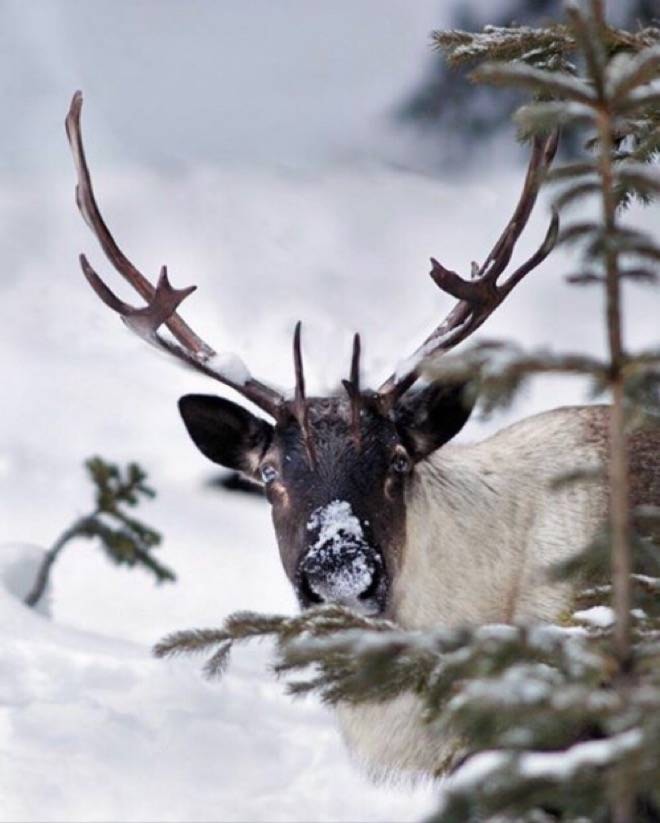I’m heartbroken. Another of our magnificent ungulate neighbours, the B.C. mountain caribou, is in trouble due to the destruction of their habitat. We are inclined to blame many causes, especially other predators, but resource extraction, urban sprawl and recreation activities cannot be ignored.
It’s hard to avoid news that the caribou herds in B.C. are declining. A friend familiar with Monashee Mountain habitat told me the caribou were already threatened there in the 1960s. I’ve also seen news of wolf culls as a strategy to avert a complete collapse of these unique ungulates.
The sad reality is that several B.C. caribou herds have declined to almost irretrievable numbers. Perhaps the numbers are now even lower. Two herds have completely collapsed.
Sarah Boyle, ecologist and project manager for Parks Canada spoke of the threats to caribou in a presentation to the South Okanagan Naturalists last fall.
Fortunately the video documentary she shared provided, at least initially, a comforting and positive approach to maintaining and perhaps even restoring some B.C. mountain caribou.
The documentary indicated that, in one herd still numbering well over a hundred animals, some success is being achieved with a natal pen. The natal pen protects and nourishes pregnant females through calving stages. Then the new families get another month of protective nurturing until strong enough to enter the wild again.
I enjoyed watching the young caribou jump, run and tumble as they mastered their gangly legs. I appreciated the intention of the project that has stabilized that particular herd and impressively brought together a diverse group of caribou supporters to do so.
But to be truthful I winced as a helicopter plowed through the air above a startled herd, all in aid of capturing pregnant females by bringing them down with a tranquillizer dart.
I confess I cringed as the sedated caribou were bundled for transport to the pen. Many wore tracking collars, evidence of past captures. The natal pen project has been in operation for several seasons providing further evidence that the caribou moms are veterans of the procedure.
Still, I shuddered.
Despite my reaction, I recognize that since we’ve decimated caribou habitat with our logging and recreation activities, we’ve become responsible for their survival, whatever that takes.
Another strategy explored in the video involved the reduction, or more accurately, a cull of moose to alleviate pressure on the caribou’s choice browse.
As a result, hunters hit the jackpot as hundreds of extra moose tags were released to facilitate the cull.
Of course, the natal pen and protection of caribou food options are just part of an overall recovery strategy.
Predator culling is also essential and the wolf population is to be reduced.
I felt more and more uncomfortable as I watched well-meaning people decide which animals should live and which should die. All in aid of saving those deemed most endangered.
I felt especially conflicted about the wolves. In some situations, wolves have been introduced to restore the predator-prey balance.
The story of their reintroduction in Yellowstone National Park offers an extraordinary rebalancing.
On Cortes Island where I lived for eighteen years, wolves were an integral part of the landscape. There I learned that we often foolishly kill the alpha male and female, leaving a batch of leaderless and confused juveniles. They are the ‘lone wolves’ who are a threat to livestock and pets.
Thus culls often create new problems by confusing animal social structures and aggravating environmental problems. As a friend says, “We make the mess and simply blame other species for it.”
How do we decide who lives and who dies? How do we decide when to intervene in a process that is often of our own making?
I know there are complex wildlife management strategies and careful calculations used to make those decisions.
But I can’t shake the feeling that we seem to be very good at destroying wildlife through negligence, greed and even good intentions.
Dianne Bersea is a member of the South Okanagan Naturalists. Views expressed do not necessarily represent SONC. southokanagannature.com
